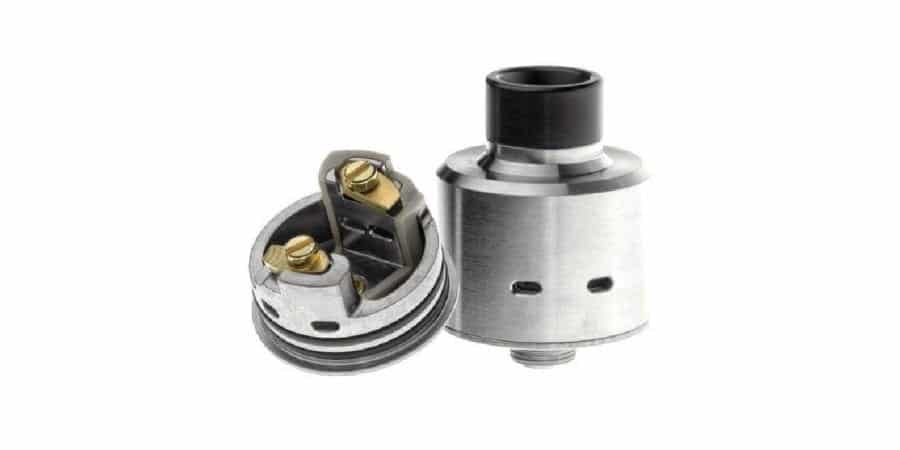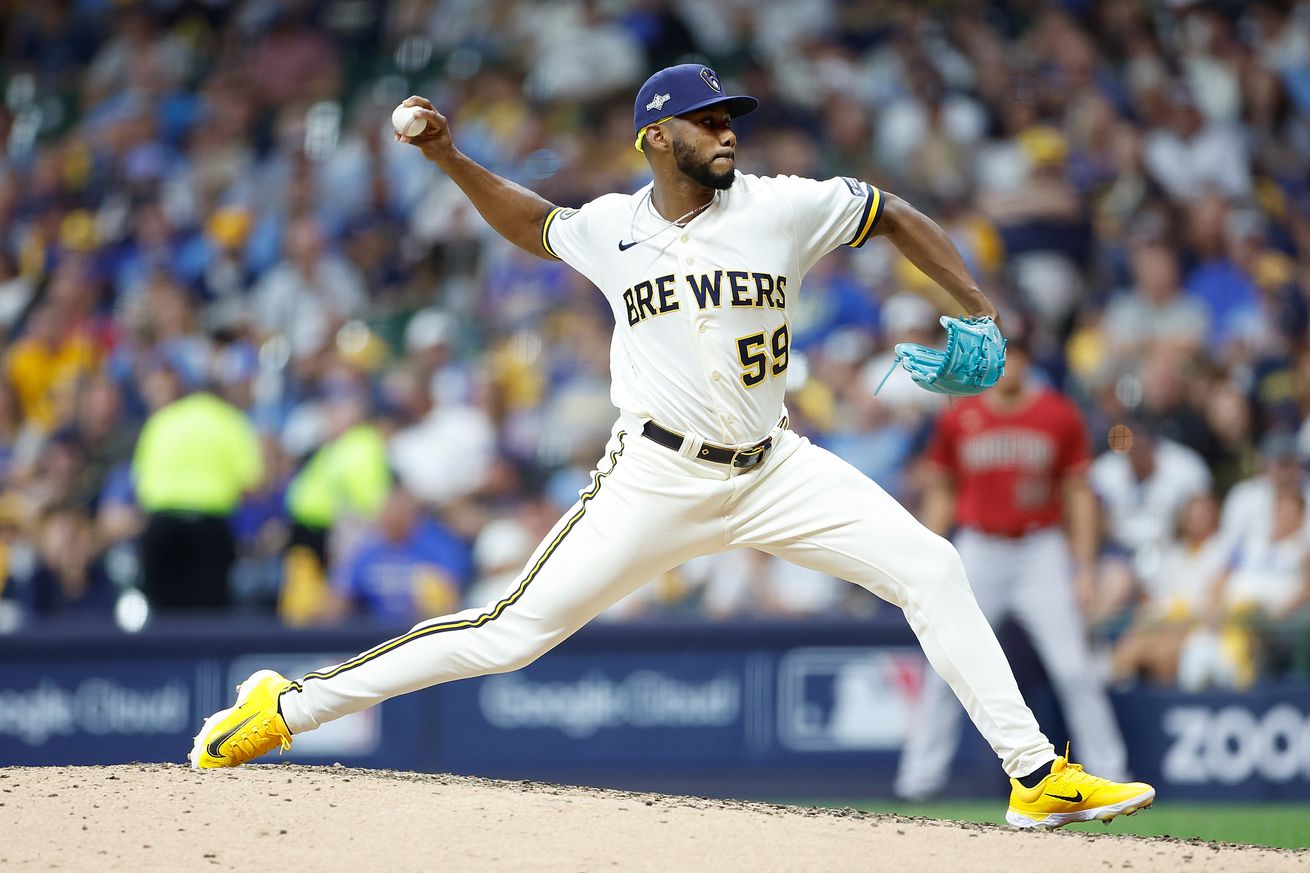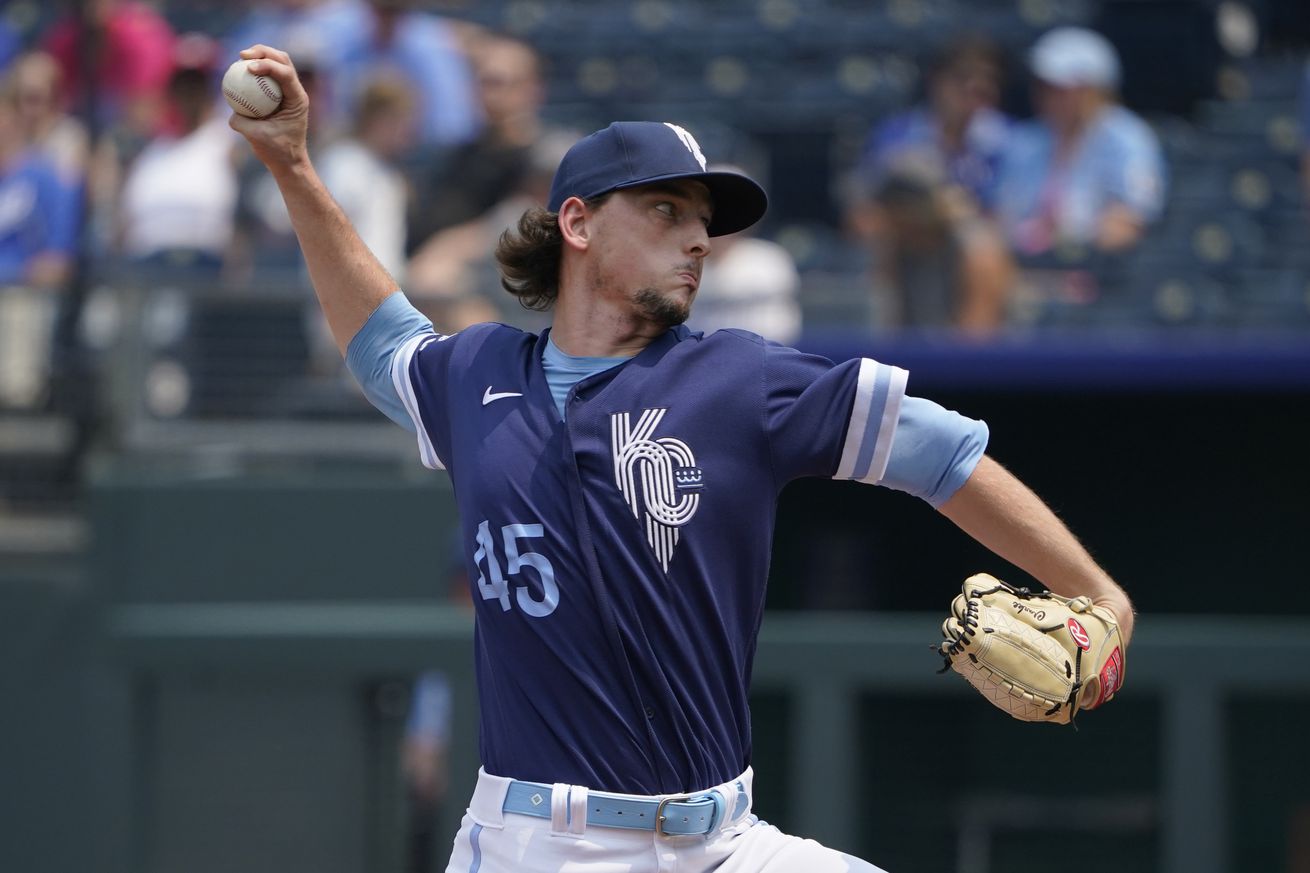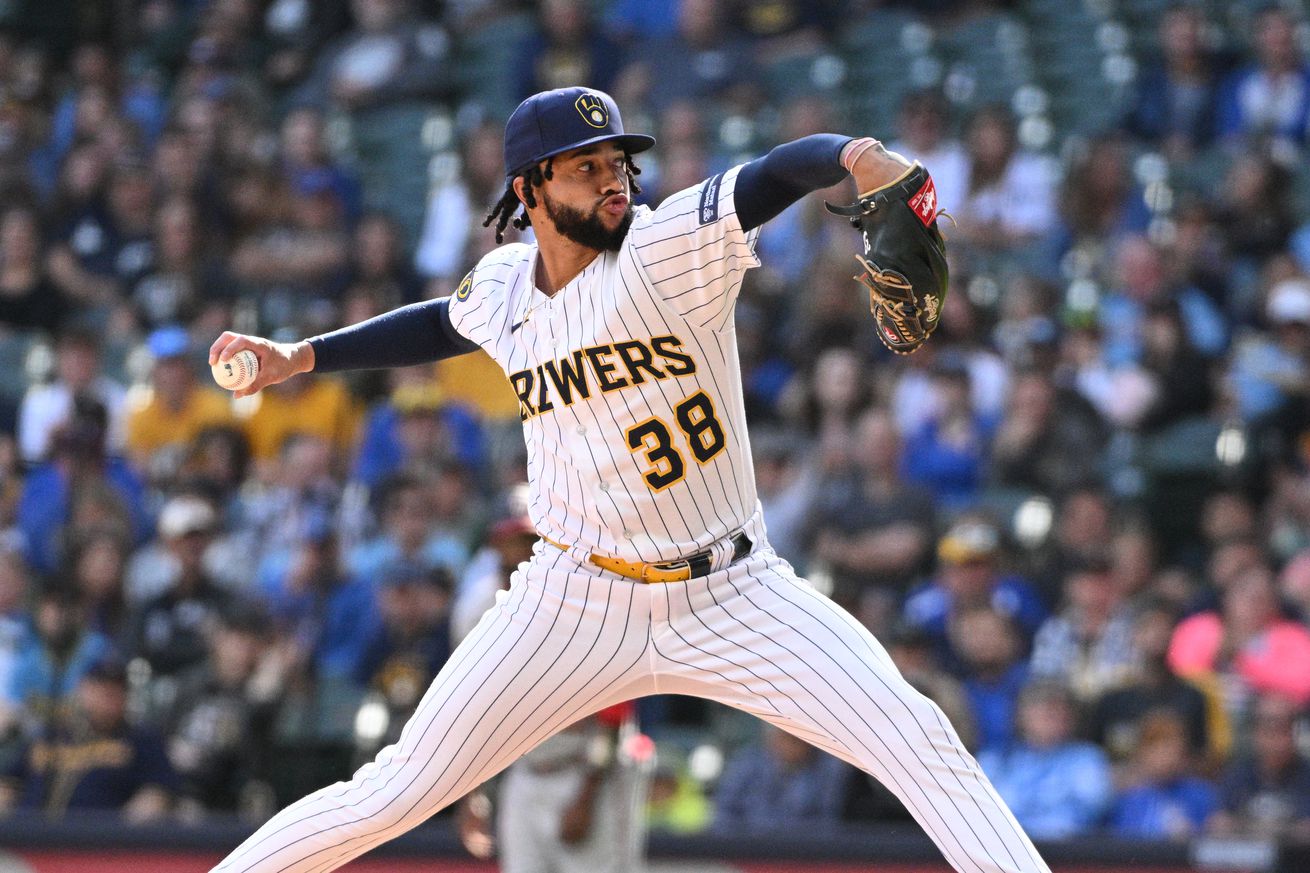Photo by Matthew Grimes Jr./Atlanta Braves/Getty Images The Brewers currently have a crowded outfield, but potential trades and lack of a DH could pave the way for some additions The Brewers currently feature one of the deepest outfields in...
 Photo by Matthew Grimes Jr./Atlanta Braves/Getty Images
Photo by Matthew Grimes Jr./Atlanta Braves/Getty Images
The Brewers currently have a crowded outfield, but potential trades and lack of a DH could pave the way for some additions
The Brewers currently feature one of the deepest outfields in baseball. The club carries eight outfielders on its 40-man roster, including recently-extended top prospect Jackson Chourio.
Still, the Brewers may be involved in the outfield market as the offseason continues. The current mix has a high ceiling but a questionable floor. Some players could be traded for upgrades at other positions. The Brewers also lack a productive DH and could add another outfielder to primarily fill that role, as they did with Andrew McCutchen two years ago.
Because the Brewers outfield situation differs from the infield or pitching staff, lets take a different approach and start by looking at some outgoing trade candidates.
Trade Candidates
Garrett Mitchell
Mitchell is a wild card at this stage in his career due to injuries and concerns about his profile. His .278/.343/.452 line (119 wRC+) is the most encouraging of the Brewers recently-graduated prospects, but it has come in a sample of just 141 plate appearances with some alarming peripherals.
Mitchells .276 xwOBA and 64 DRC+ indicate that he has actually performed poorly against big-league pitching and benefited from highly favorable batted ball luck. His .441 BABIP is about 1.5 times the MLB average of .293 during that time.
Mitchell has excelled at making ideal contact when he puts the ball in play, posting an elite 40.5% sweet spot percentage on batted balls. That means hes making contact on the right spot of the bat to produce lots of line drives and base hits. If he can keep that up, hell sustain a high BABIP, albeit nowhere close to .441.
Unfortunately, Mitchell doesnt make nearly enough contact overall. His strikeout rates in the minor leagues were concerning, and he has punched out at a 38.3% rate against MLB pitching. When he was a prospect, some scouts were concerned about his swing path making it difficult for him to hit high fastballs. Those concerns followed him to the big leagues, as Mitchell has whiffed at alarming rates against elevated heat.
Furthermore, his quality of contact was not nearly as encouraging in the minor leagues. Mitchell has a career 60.6% ground ball rate and a 15.3% line drive rate in the minors. Such suboptimal contact prevents Mitchell from tapping into his raw power. A player who either swings and misses or hits the ball on the ground most of the time doesnt profile as a productive hitter.
Mitchells elite speed, defense, and raw power give him perhaps the highest ceiling of the Brewers young outfielders, but he also has one of the lowest offensive floors. Now that Joey Wiemer and Sal Frelick have proven they can play plus defense in center field, Mitchell appears to be Milwaukees most expendable young talent.
On top of the concerns about Mitchells profile, a significant shoulder injury shelved him for most of the 2023 season and prevented the baseball world from evaluating where hes at in his development. His trade value may not be limited.
Joey Wiemer
Wiemer is similar to Mitchell in that hes an immensely talented raw athlete with serious flaws that give him a low floor as a hitter.
Like Mitchell, Wiemer is an elite defensive center fielder with impressive power. Whereas Mitchell struggles with velocity, Wiemers fidgety load and violent swing lead him to open up far too early in his swing, often rendering him helpless against breaking pitches. Wiemer hit .160 with a .205 wOBA against breaking balls as a rookie and was practically guaranteed to be out in front unless the pitch missed over the inner third of the plate.
Wiemers long-term outlook and trade value are slightly better than Mitchells. He has shown better results against fastballs and looked like a viable platoon piece, posting an .815 OPS against left-handed pitching in his rookie season. Still, he has a long way to go before he profiles as a reliable everyday bat.
Sal Frelick
Frelick may hold the most trade value of the three outfielders. Offensively, he is the inverse of Mitchell and Wiemer. Frelick rarely makes loud contact, but hes a consistent on-base machine due to his smart swing decisions and excellent bat control.
Frelick walked in 10.3% of his minor-league plate appearances while striking out at just an 11.7% clip. It was more of the same as a big-league rookie, as Frelick posted a 12.6% walk rate against a 16.6% strikeout rate. At the same time, he would have ranked near the bottom of the league in most quality of contact metrics if he had enough plate appearances to qualify. The lack of hard contact limited him to a 91 wRC+.
Due to his excellent plate discipline, Frelicks floor shouldnt be too much lower than his rookie showing. Its difficult to imagine him being anything more than a solid hitter unless he develops home run power, but any team employing Frelick should feel confident in his ability to consistently be a roughly average bat and a strong defender in center field. The certainty he provides relative to other young players means he could net the best return.
Tyrone Taylor
While Mitchell, Wiemer, and Frelick will likely have their names floated as trade candidates for the remainder of the offseason, the Brewers shouldnt feel any pressure to move them. All three are in the infancy of their careers and have multiple option years remaining. Theres no harm in sending one or multiple of them to Triple-A for regular at-bats.
The Brewers could also keep their youth movement fully intact by dealing Tyrone Taylor instead. The 29-year-old owns a 102 wRC+ across parts of five MLB seasons and is an above-average defender at all three outfield positions, making him a valuable fourth outfielder.
Taylor is unlikely to garner a significant return, but he could be part of a small trade with a team heavy on infielders but lacking outfield depth.
Whether the Brewers trade from their outfield or not, here are a few hitters they could pursue to rotate through the DH and corner outfield positions.
Free Agent Targets
Eddie Rosario
The Brewers were reportedly interested in Rosario in 2021 before he signed with the Cleveland Guardians. Three seasons later, he could fit the roster nicely despite Milwaukees glut of outfielders.
Rosario is one of baseballs most aggressive hitters, leading to low on-base percentages that limit his upside. However, hes been a consistently serviceable bat.
Since the start of 2017, the 32-year-old has slashed .269/.309/.465 for a 104 wRC+, averaging 27 home runs per 162 games. His only below-average offensive season during that span was a nightmarish 2022. Rosario struggled with vision issues that year and underwent corrective surgery. He rebounded with a 100 wRC+ in 2023.
The Braves declined Rosarios $9 million club option for 2024, perhaps due to concerns about his once-strong contact rates declining over the past two seasons. He made contact on pitches in the zone at a career-worst 79.8% rate last year.
Still, Rosarios low price tag makes him a nice budget option for the Brewers to lengthen one of the weakest lineups in the National League. Rosario was an everyday left fielder last season but could divide his time among corner outfield and DH with Milwaukee.
J.D. Martinez
Martinez is essentially a full-time DH at this stage of his career and spent all of 12 innings in the field last year. He makes the list because all of his defensive experience is in the outfield, the Brewers need offense at DH, and Martinez should be available on a short-term deal.
The 36-year-old smashed 33 home runs last year with the Los Angeles Dodgers, hitting .271/.321/.572 for a 135 wRC+.
Martinezs strikeout rate ballooned to a concerning 31.1% clip, but it was a worthwhile tradeoff for some of the loudest contact of his career. He set career-highs with a 93.4 mph average exit velocity and a 55.1% hard hit rate, leading to a .369 xwOBA identical to his actual wOBA.
That power could evaporate quickly if Martinez loses bat speed, so he carries a good deal of risk despite his reputation as one of the best power hitters of the last 10 years. Still, hes arguably the best short-term gamble in a free-agent market that lacks bona fide impact bats.
Joc Pederson
Pedersons .235/.348/.416 line (111 wRC+) in 2023 was not nearly as flashy as Martinezs output, and hes a strict platoon bat who needs to be shielded against lefties. That said, he may be a safer investment for a few reasons.
Pederson turns 32 next year, so he doesnt share Martinezs age concerns. He also has better plate discipline. In 2023, he cut his strikeout rate to a career-best 20.9% and walked at a 13.4% clip. He didnt hit the ball quite as hard as Martinez, but his 52.2% percent hard hit rate and 92.1 mph average exit velocity ranked in the 96th and 91st percentiles, respectively. His .367 xwOBA was nearly identical to Martinezs.
Pederson also provides more flexibility in the field, appearing in 38 games as a corner outfielder last year and working primarily as a left fielder in 2022. He graded as one of the worst defensive outfielders in baseball that year, but his ability to play the field part-time would allow the Brewers to get other players, namely Christian Yelich, off their feet with sporadic days as the DH.
Due to his younger age and solid two-year run with the San Francisco Giants, Pederson should land at least a two-year guarantee. The Brewers might be wary of committing multiple years to a platoon player as their DH, but with the arbitration salaries of Corbin Burnes and Willy Adames coming off the books after 2024, Pederson would fit in their medium-term budget.













